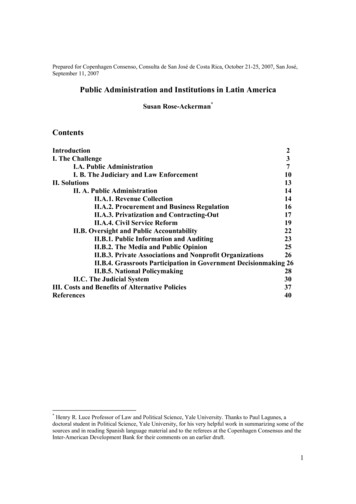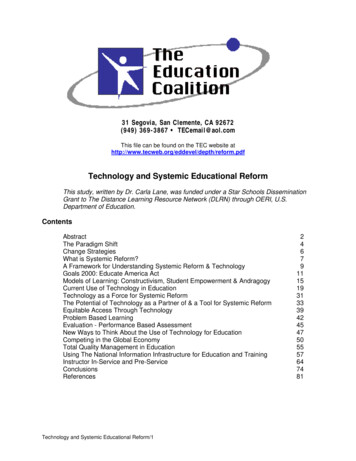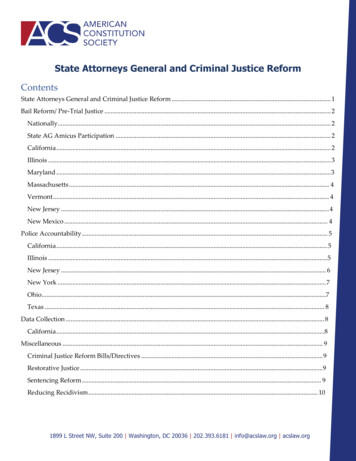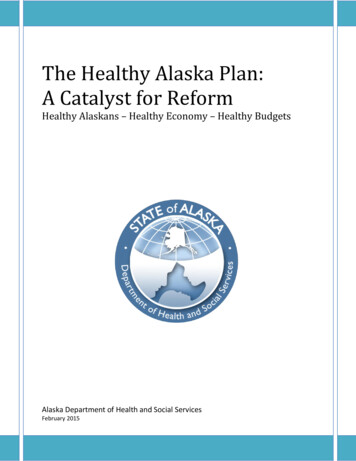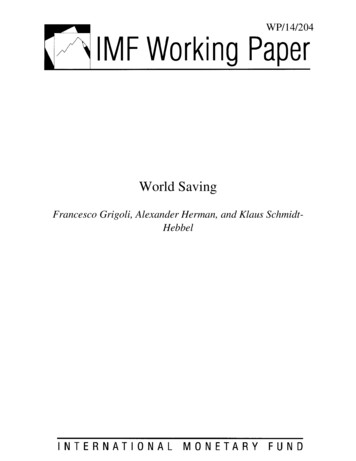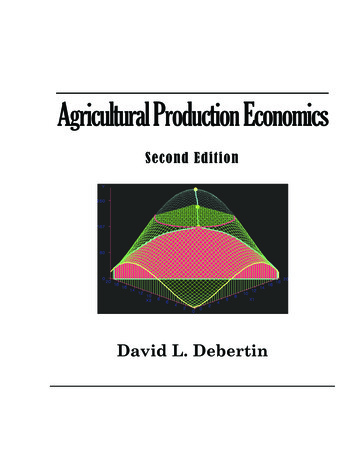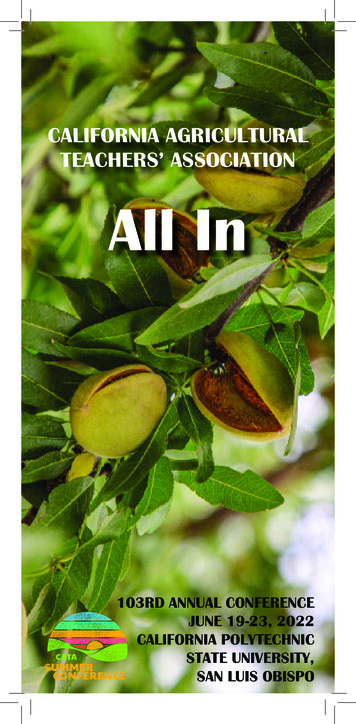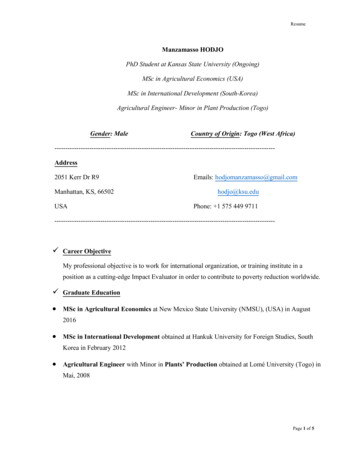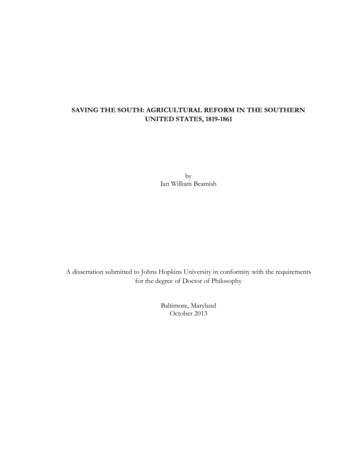
Transcription
SAVING THE SOUTH: AGRICULTURAL REFORM IN THE SOUTHERNUNITED STATES, 1819-1861byIan William BeamishA dissertation submitted to Johns Hopkins University in conformity with the requirementsfor the degree of Doctor of PhilosophyBaltimore, MarylandOctober 2013
ABSTRACTThis dissertation re-assesses how the popular national agricultural reform movementoperated in the southern states and how it interacted with the economy of slavery and shortstaple cotton. The central question that my dissertation explores is how the agriculturalreform movement was used and interpreted by reformers and other planters, including howit changed the daily lives of slaves on cotton plantations. Drawing on print sources from theagricultural press, plantation journals and work logs, and slave narratives, this study exploreshow planter elites used agricultural reform to articulate their goals for and anxieties about thefuture of their plantation society, as well as the unexpected legacy of reform on theplantation. By moving away from previous scholarship’s singular focus on agriculturalliterature and societies, this dissertation shows how the ideas of agricultural reform filteredout to planters across the cotton South. Only by considering all three elements ofagricultural reform—the public world of reformers, agricultural labor on cotton plantations,and the work of slaves on those same plantations—is it possible to offer a full picture ofagricultural reform in the South. This study shows the reach of agricultural reform bycombining studies of the print and social worlds of reformers, the account books and nonliterary print that popularized reform in the Southwest, cotton work, and plantation casestudies. This dissertation traces the intellectual history of southern elites to fundamentalchanges in the lives of planters, overseers, and slaves in the cotton South.ii
ACKNOWLEDGMENTSMy dissertation would not have been possible without the support, encouragement,and advice of my advisor, Michael Johnson. Mike constantly pushed me to think morecarefully and fully about my sources, shaping the writing of this dissertation. Despite takinggreat care not to determine my focus or argument, Mike made sure that I alwaysremembered to question my sources and consider why my historical actors were behaving asthey were. The other members of my committee also shaped my dissertation in importantways. Ron Walters asked me to move out of my comfort zone and think more broadly aboutthe types of narratives historians use, how to connect my work to broader trends in reform,and to re-evaluate the analytical categories and labels that I chose to use. Phil Morganprovided a constant push to expand and clarify claims. The issues remaining with this projectare a result of my not being able to take and implement all of the generous advice of thesementors. I would also like to thank Professors Matthew Crenson and Robert Kargon whotook the time to read the entirety of my dissertation and offer generous and perceptivecomments. Pier Larson and Richard Kagan also deserve thanks for their roles in helping medevelop both as a scholar and a teacher.My dissertation has benefitted incredibly from the aid of librarians and archivistsacross the country. I would like to particularly thank the staff at the Mississippi Departmentof Archives and History for not only helping me find relevant documents, but also forhelping me navigate the complex genealogies of planter families in the nineteenth-century. Iwould also like to thank the librarians at both the Special Collections Department of theLouisiana State University Library who provided me with invaluable guides-in-progress tothe Thomas Affleck Papers and at the South Caroliniana Library in Columbia. In addition, Iiii
am incredibly grateful to the institutions that offered me support to travel to and work intheir archives—the Institute for Southern Studies in Columbia, the Library Company ofPhiladelphia, and the American Antiquarian Society in Worcester, Massachusetts. I wouldlike to single out the Chemical Heritage Foundation in Philadelphia for providing me with ayear of support to finish my dissertation in an incredibly welcoming and intellectuallystimulating environment. At the CHF, I benefitted greatly from exposure to the history ofscience and technology and from interactions with the other fellows, especially Laura Kalba,Mat Savelli, Joel Klein, and Ben Gross. I would also like to thank Ron Brashear and CarinBerkowitz for making the CHF such a friendly but productive place to hold a fellowship.Much of this dissertation was written in coffee shops and I would like to thank the ownersand staff of Charmington’s (and Charles Village Pub) in Baltimore, Chapterhouse inPhiladelphia, and Transcend in Edmonton for not only tolerating my regular presence, butwelcoming me.My work has benefitted greatly from the supportive criticism that I received atseminars, colloquiums, and conferences. I am especially grateful to Paul Erickson, JeanineDeLombard, and Lloyd Pratt for bringing me to the Summer Seminar in Book History at theAmerican Antiquarian Society and to the other participants in the seminar, especially J.Brenton Stewart. My work has also been shaped by my experience at the Slavery’s Capitalismconference at Harvard and Brown, convened by Seth Rockman and Sven Beckert. LorenaWalsh, Caitlin Rosenthal, Ronald Bailey, John Majewski, John Bezis-Selfa, Dan Rood, andEdward Baptist offered invaluable comments. I would also like to thank all of those whohave provided such generous and incisive comments on my work at other seminars andconferences, especially Max Edelson, Susan O’Donovan, Cathy Matson, Emily Pawley, LeonJackson, Paul Rhode, and Alan Olmstead. Ariel Ron has provided many thoughtful,iv
perceptive conversations about agricultural reform. At Hopkins, I have presented drafts ofmost of my chapters to the Nineteenth-Century Seminar. I owe a great deal to thethoughtful comments offered by Patrick Luck, Craig Hollander, David Schley, Rob Gamble,Steffi Cerato, Jessica Ziparo, Katie Hemphill, Steph Gamble, and Noah Cincinnati. JustinRoberts has not only read countless drafts of my work, but has also been a generous mentorand colleague.The community that I found at Johns Hopkins was vital to helping me get throughthe research and writing process. I thankfully found dissertating to be anything but lonely. Ientered graduate school with a wonderful cohort of colleagues, many of whom are nowclose friends. Basketball provided a frequent distraction from writing and, despite our failureto win the elusive championship, and I am grateful to the faculty and graduate students ofthe History and English departments who played on the many iterations of our intermuralteam. I would especially like to thank Jess Clark, Khalid Kurji, and Alex Orquiza. While weare now scattered from Baltimore to Kyrgyzstan, each of them helped me learn how to be agraduate student and academic. My fellow members of Canada House, Kenneth Sheppardand Christopher Stolarski, were excellent colleagues and better friends. Beyond my cohort,many wonderful friends enriched my life and work in Baltimore, especially Natalie Elder,Laurel Flinn, Jonathan Gienapp, Claire Gherini, Katie Hindmarch-Watson, Jason Hoppe,James Kuzner, Ren Pepitone, and Katie Reinhart. Will Brown has been a great friend and,just as importantly, a fellow NBA fan. Gabriel Klehr and Alice Wiemers became two of myclosest friends over the course of graduate school and deserve particular recognition fortolerating and supporting me even when I was not at my best. I should acknowledge Alice’sparticular contribution as a colleague who has not only been a reliable coworker at variouscoffee shops but also endured many early drafts of chapters and offered encouragement asv
she helped re-shape them into coherent pieces. Together, many of the friends and colleaguesthat I have met over the course of working on this project will stay with me for life.Back in Canada, I would like to thank several close friends for providing muchneeded grounding outside of history. Jason Wu, Jeff Tsui, June Cheng, Tina Marx, DegjuSuwal, Wilmer Bong, and William Lin have all provided me with lasting friendships andvalued visits to Baltimore. Most of all, I would like to thank my family for their support (inall forms) throughout the dissertation process. My aunts and uncles have been unreasonablyencouraging about my prolonged studies in the history of a foreign country. My sister, LeighBeamish, provided an example of determination and perseverance (despite being two yearsmy junior) in her own studies and work as a medical doctor. My parents, John Beamish andKathleen Pine, have never wavered in their support of my studies and deserve the finalacknowledgments (and not just for proof-reading the dissertation). Not only have myparents fostered my work over the past few years, but they set me down the path towardsthis dissertation. My father, I now realize, is the reason I decided to pursue a doctorate.Throughout his career as a professor of physics, he has been a reminder that work inacademia can be a rewarding part of a balanced life. My mother, a librarian, set me on mypath towards history with her steady encouragement of reading and learning. I cannot thankthem enough for all that they have done for me.vi
Table of ContentsIntroduction . 1Chapter One : Light Fingers and Heavy Hearts: Cotton Work and the Whip . 47Chapter Two : The Structure of Agricultural Reform in South Carolina, 1828-1861. 98Chapter Three : Reform in Practice: Thomas Affleck’s Plantation Record and Account Book . 149Chapter Four : Reform on the Plantation: Cotton Slavery and the Metcalfe PlantationEnterprise . 190Conclusion. 245Appendices . 256Bibliography . 268vii
List of TablesTable 2.1: Geographic Focus of Articles Published in the Southern Agriculturist, 1828 . 118Table 3.1: Paid Subscriptions to the Southern Planter, 1842. 163Table 3.2: Use of Forms in Affleck Book . 178Table 4.1: Roles of Metcalfe Plantations within the Larger Enterprise . 207Table 4.2: Other Metcalfe Plantations in the Bourbon Plantation Record, 1860 . 209Table 4.3: Workflow Chart for Bourbon, 1860 . 227Table 4.4: Most Common Cotton-Related Work by Month at Bourbon, 1860 . 230Table 4.5: Work During the First Four Weeks of Cotton Picking, York, 1852. 232Table 4.6: Construction Work at Bourbon, 1860 . 233Table 4.7: Slave Labor During Cotton Picking in South Carolina and Mississippi . 240viii
List of FiguresFigure 2.1: Journals Published and Cotton Prices Per Pound . 108Figure 2.2: Origin of Articles in the Southern Agriculturist, 1828-1841 . 119Figure 2.3: Focus of Articles in the Southern Agriculturist, 1828-1841. 120Figure 2.4: Contributors to the Southern Agriculturist, 1828 . 123Figure 2.5: Agents for the Farmer and Planter, August, 1859. 129Figure 2.6: Agricultural Societies in South Carolina, 1823 . 132Figure 2.7: Agricultural Societies in South Carolina, 1841 . 136Figure 3.1: John Murray, Weather Observations . 152Figure 3.2: Locations of Plantations in Affleck Sample . 172Figure 3.3: James Harrington Plantation Journal. 182Figure 3.4: Willow Point Plantation Journal. 183Figure 3.5: Joseph Jaynes Plantation Journal. 185Figure 4.1: Bourbon and Montrose Plantations . 190Figure 4.2: Natchez Region, Mississippi, 1860. 199Figure 4.3: Metcalfe Plantations in Adams County, 1860 . 202Figure 4.4: Former Cotton Field, Bourbon Plantation . 223ix
Introduction“I understand all about the growth of cotton, from the time of preparing the land to receivethe seed, till the wool is jinned and packed. I am a good judge of its quality, too, and knowwhat is the best kind of jin for various sorts. I do not say this for the sake of boasting. Myknowledge has not come naturally to me. I have acquired it in a very hard school, and I wantto turn it to account.”John Brown, edited by Louis Alexis Chamerovzow, Slave Life in Georgia: A Narrative of the Life, Sufferings,and Escape of John Brown, a Fugitive Slave in New England. London: W.M. Watts, 1855, 208.John Brown was a slave on a Georgia cotton plantation when he acquired hisknowledge of cotton agriculture. Like countless other slaves across the American South,Brown needed to know the most intimate details of how planters wanted to grow cotton—his life depended upon it. Planters across the cotton South took interest in the details ofplantation agriculture and tried to extract as much cotton as they could from their land andslaves. For many of these men, this meant engaging with the popular agricultural reformmovement that published manuals on cotton planting, journals offering advice on the detailsof running a plantation, and blank record forms to guide cotton planters through thebusiness of planting, cultivating, harvesting, and selling the white fiber. When their masterstook an interest in agricultural reform, slaves often paid the price. Agricultural reform in thecotton South emphasized efficiency, eliminating slack periods in the labor cycle, closelymonitoring slave labor, and adopting new varieties of the cotton plant that produced moreand larger bolls for slaves to pick.My dissertation, “Saving the South: Agricultural Reform in the Southern UnitedStates, 1819-1861” examines how the popular national agricultural reform movement wastranslated to the southern states and how it interacted with the economy of slavery andshort-staple cotton. The dissertation is a study of cotton plantations, agricultural reform, andslave labor in South Carolina and Mississippi. Between 1820 and 1861, the cotton economy1
of the plantation South exploded, expanding the reach of slavery and staple production. Atthe same time, the United States was undergoing a dramatic reshaping of its nationaleconomy in the face of industrialization and changing approaches to labor management.Cotton planters in the South selectively appropriated elements of rational production andagricultural reform in an attempt both to follow trends in the national and transnationalknowledge networks with which they engaged and extract as much as possible from land andslave labor. These reformers saw re-making plantation agriculture as the only way to securethe future of a slave South.The central question that my dissertation explores is how the agricultural reformmovement was used and interpreted by reformers and other planters, including how itchanged the daily lives of slaves on cotton plantations. Drawing on print sources from theagricultural press and manuscript correspondence and plantation journals and work logs, Iexplore the ways that planter elites used agricultural reform to articulate their goals for andanxieties about the future of their plantation society, as well as the unexpected legacy ofreform on the plantation. Focusing on both elites’ agendas and slave labor, I was able to seehow the intellectual history of southern elites can be directly traced to fundamental changesin the lives of planters, overseers, and slaves. Southern agricultural reform was an adaptive,reactive movement that shifted its form to follow the course of plantation slavery in theUnited States. Unlike the national agricultural reform movement, southern reform was notdefined by a specific set of agricultural practices, but rather served the interests of planterreformers who were determined to ensure a prosperous future for slave-based plantationagriculture. These men differed from reformers in other parts of the nation, in that theypossessed the social authority that other reformers aspired to. The major goal of southernagricultural reform was to keep slavery and plantation agriculture profitable and competitive2
with other modes of production. This produced a movement focused on findinginefficiencies in agricultural production, rather than a movement determined to manage soilfertility sustainably. Agricultural reform in the American South was interested in politicaleconomy as much as agronomy.The project differs from most previous work on agricultural reform and change inthe American South in that it does not assume that this movement “failed” in the South.Scholars, and indeed some contemporary historical actors, mistook the intentional limitingof agricultural reform to planters and select experts as failure. Southern agricultural reformwas never meant to extend beyond this small constituency, an intention that had thepractical effect of precluding a sweeping popular movement, such as that of the Northeast.Southern elites saw plantation agriculture as synonymous with southern society andeconomy, making any truly democratic attempt to reform it inherently dangerous. Plantersmade agricultural reform about much more than agriculture; reform was a safe place todiscuss potentially destabilizing issues like education for the lower classes, skilled andmanagerial work for slaves, and the precarious economic and political place of southernstates nationally. In political forums, questioning the class and labor foundations ofplantation society was unthinkable, given the desperate need for stability in a slave society. Iargue that the increasing presence of print on the plantation brought this agricultural reformmovement into the daily lives of slaves across the South.This dissertation breaks from extant definitions of agricultural reform by locating thecore of the movement in a desire to increase the profits of plantation agriculture and tofurther the plantation political economy, rather than in a set of reforms centered on soilfertility and specific agricultural practices. The literature on southern agricultural reform hasimported two assumptions from the standard story of agricultural reform: that agricultural3
reform was about specific agrarian practices, usually centered on soil, and that it wasdesigned to have popular appeal to all white landowning agricultural producers. I argue thatthese terms do not apply to the South and they have masked the genuine goals of southernagricultural improvement in the South—a political economic project to make plantationslavery consistent with a changing American economy, protecting the planter class and itsvision of southern society. Agricultural reform influenced Mississippi cotton planters whodid not marl their fields just as it did a Virginia planter who assiduously followed EdmundRuffin’s principles.1 The movement was defined by its commitment to constant adaptation,innovation, and experimentation in all forms towards its ultimate goal of financial success,regardless of the human cost that slaves paid.Agricultural Improvement in the Eighteenth-Century SouthGeorge Washington was at the forefront of an early generation of southernAmerican agricultural improvers. While Washington only traveled once outside of thecolonies that would form the United States, his visit to the West Indian island of Barbadosrepresents an important connection for agricultural reform in the American South. In 1751,when Washington’s brother, Lawrence, was suffering from tuberculosis, the two siblingssailed to the tiny colony in the hopes that the warm weather would help Lawrence’srecovery. During their four-month stay, George spent much of his time (when notrecovering from smallpox) riding around Barbados’ plantation landscape. At the time,planters in Barbados were beginning to embrace the Enlightenment idea of improvement, as1Marl is a mud or stone rich in lime or calcium carbonate. It was commonly found in coastal areas of thesouthern states and planters would have their slaves dig it up and load it onto carts of boats for transport to thefield, where it would be deposited, spread, and sometimes plowed into the soil. Much like lime, marl raises thepH of soils, making them less acidic, and provides calcium to crops. It was the central plank of EdmundRuffin’s platform for southern agricultural reform.4
it applied to their plantations. Some of these planters and their agents began to useplantation record books and work logs to keep track of how and where their slaves wereworking. The books served to monitor their white managers and provide an account ofplantation labor so that planters could quantify the work that slaves were doing.Additionally, since all of the viable plantation land on Barbados had been cultivated,Barbadian plantations were worked much more intensively than Virginian ones, not just interms of the density of cultivated acres but also in terms of the measures used to restorefertility to the land. The plantations were heavily and regularly manured, plant refuse wasplowed back into the ground, and managers closely monitored the soil.When Washington returned to Virginia, he brought back with him a still-ill brother,immunity to smallpox (smallpox immunity), and new ideas about plantation management. Adecade later, in the 1760s, Virginia planters held Washington’s Mount Vernon plantation upas a paragon of improved cultivation. The future president used watches and clocks to studyand monitor the work of his slaves, divided his slave workforce into more flexible “squads”which he carefully deployed around his plantation, and kept detailed work logs to track workand production.2These practices anticipated the adoption of new business practices in much of theSouth by many decades, but they do point to an important, and often overlooked,connection between the South and the Caribbean. While the print culture of southernreform draws very little on Caribbean works, the plantation records and accounts that wouldsweep the South in the 1840s and 1850s were direct descendants of Caribbean recordkeepingpractices. On many of the English sugar islands, absentee plantation owners were the ruleand plantation enterprises often involved massive capital investments that owners wanted toJustin Roberts, Slavery and the Enlightenment in the British Atlantic, 1750-1807 (Cambridge: Cambridge UniversityPress, 2013).25
track as closely as possible. As a result, they hired local attorneys to watch over theirplantations. These agents often took responsibility for a number of plantations and delegatedthe daily management to white overseers. Beneath the attorneys and overseers was acomplex web of white and slave management, all of which plantation owners wanted tomonitor. The solution, for many, was to have their agents assemble annual books gatheringtogether the daily records of the overseers and other managers. These annual books wouldthen be shipped back to Britain for the owner and his accountants to examine and commenton. As Washington’s case illustrates, southern planters slowly became aware of thesebookkeeping practices and adapted them to their own needs.Washington was not just an early experimenter with industrial discipline, clock work,and plantation accounting, he was also in the first wave of gentlemen Virginia planters toswitch from tobacco, long the staple of the Virginia economy, to wheat and other grains.Grains became a viable crop for planters as tobacco prices declined and prices for the leafdeclined. In making this shift, Washington and other northern Virginia planters of the 1770sand 1780s triggered a series of changes in agricultural practice. Tobacco had been cultivatedintensively on the same fields year after year, depleting the soil and establishing anagricultural calendar with clear periods of more and less intense work for slaves. The grains,however, involved a different system of cultivation, one that drew on the works of earlyVirginia agricultural writers like John Binns and John Taylor of Caroline, advocatingmethods of shifting cultivation, where fields that had been planted in grain one year wouldbe rested the next year, planted only in clover.3 Grain also required new implements andmethods of harvesting and processing. These changes drew in artisans and inventors andmade machinery and improved tools a central element of agricultural improvement.John Binns, A Treatis on Practical Farming (John A. Binns, 1803); John Taylor, Arator: Being a Series of AgriculturalEssays, Practical & Political, in Sixty-One Numbers (J.M. Carter, 1814).36
Influential writers like Taylor also emphasized the importance of keeping the slaveworkforce fully occupied, both for efficiency and safety—idle slaves were thought to be arisk to revolt.Improvement in the Early RepublicIn the decades after the American Revolution, southern agricultural improvementwas most celebrated in Virginia. Nationally, learned elites established agricultural societies inBoston, Philadelphia, Charleston, and other American cities. These societies modeledthemselves after scientific societies that participated in Atlantic networks of knowledge.Much like members of scientific societies in early America, the men in these improvementsocieties wanted to establish their credibility and authority as much as they were interested inchanging the practice of agriculture. Contrary to its own rhetoric, agricultural improvementwas very much an intellectual movement, not a practical one. In 1817, some of the mostprominent agricultural improvers (and Virginians) gathered together to form the AlbemarleAgricultural Society. Thomas Jefferson, James Madison, and a number of prominentpoliticians lent weight to the organization and John Skinner, who two years later wouldpublish the first major national agricultural journal, the American Farmer, gave intellectualauthority to the society. In the next few years, several significant societies were organized,including the Fredericksburg Agricultural Society in northern Virginia and the RoanokeAgricultural Society in southern Virginia, where tobacco still ruled the fields.4 These societieswere dominated by wealthy planters who were interested in improving the agriculture of thestate through soil management, better implements, and crop selection. The vast majority ofthe agricultural reformers of this period were men who could afford to take significant4Charles W. Turner, “Virginia Agricultural Reform, 1815-1860” Agricultural History 26 (July 1952), 81.7
financial risks and invest considerable capital into uncertain new agricultural projects. Whilemany scholars have argued that southern agriculture was doomed by the refusal of southernfarmers and planters to heed the advice of reformers, sticking to established practice was amuch safer financial strategy. Thomas Jefferson, a wealthy man and ambitious reformer, diedwith his plantations heavily mortgaged. Through the first decade or two of the nineteenthcentury, agricultural reform in the South was the preserve of the established planter elite.The other wealthy and influential group of planters in this period was the rice andSea Island cotton planters of the Carolina and (to a lesser extent) Georgia Lowcountry.These men had different agricultural problems than the Virginia planters who started therenowned agricultural societies. For the South Carolina planter gentry, the major issues wereless the declining fertility of the Lowcountry, which still produced large crops, than thetension between an established rice and Sea Island cotton economy and the emerging shortstaple cotton economy. Rice and Sea Island, or long-staple, cotton were grown almostexclusively in the tidal Lowcountry. When short-staple cotton emerged, planters had alreadyspent over a century forcing their slave workforces to transform swampland into an irrigatedlandscape tenuously maintained b
combining studies of the print and social worlds of reformers, the account books and non-literary print that popularized reform in the Southwest, cotton work, and plantation case studies. This dissertation traces the intellectual history of southern elites to fundamental changes in the lives of planters, overseers, and slaves in the cotton South.



